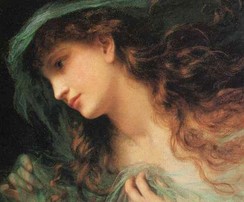
A nymph is any member of a large class of female nature entities, either bound to a particular location or landform or joining the retinue of a god or goddess, particularly Artemis, goddess of the hunt. Nymphs were the frequent target of lusty satyrs.
"The idea that rivers are gods and springs divine nymphs," Walter Burkert remarks (Burkert III.3.3) "is deeply rooted not only in poetry but in belief and ritual; the worship of these deities is limited only by the fact that they are inseparably identified with a specific locality." Nymphs are personifications of the creative and fostering activities of nature, most often identified with the life-giving outflow of springs. The Greek word νύμφη has "bride" and "veiled" among its meanings: hence, a marriagable young woman. Other readers refer the word (and also Latin nubere and German Knospe) to a root expressing the idea of "swelling" (according to Hesychius, one of the meanings of νύμφη is "rose-bud"). The home of the nymphs is on mountains and in groves, by springs and rivers, in valleys and cool grottoes. They are frequently associated with the superior divinities: the huntress Artemis; the prophetic Apollo; the reveller and god of wine, Dionysus; and with rustic gods such as Pan and Hermes (as the god of shepherds).
The symbolic marriage with a nymph of a patriarchal leader, often the eponym of a people, is repeated endlessly in Greek origin myths; clearly such a union lent authority to the archaic king and to his line.
Nymphs take the appearance of young, beautiful, gentle girls. They are not immortal, though they are very long-lived, and their lives end with the death of a particular natural object, such as a tree, to which they are attached. Often wrshipped in grottoes and natural shrines, Nymphs personify the fertile and creative powers of nature, such as the life-giving flow of fresh-water springs.
Various aspects of nature have their own particular kind if Nymph:
Water Nymphs, called Nereids, are similar to Mermaids. The 3,000 Oceanids, the Nymphs of the oceans, are the daughters of the Titans Oceanus and Tethys.
Land Nymphs are
linked to particular geographic locations. Oreids, who inhabit mountains and ravines, often accompany Artemis on hunting expeditions. Alseids protect glens and groves, while Auloniads are found in pastures and mountain valleys, often in the retinue of Pan.
Wood Nymphs are identified with particular species of trees. Often their bodies become part of the trees they inhabit. Dryads are associated with oak trees, Hamadryads with nut, elm and
fig trees, and Meliae with ash trees. Ovid tells the story of Daphne, the Nymph who becomes a laurel tree. The god of love Eros wounds Apollo the god of the Sun, with an arrow, causing him to fall in love with Daphne, daughter of the river god Peneus. A follower of Artemis and vowed to chastity, Daphne runs away from her pursuer. Just as Apollo is about to catch her, Daphne cries out to her father for help. The moment the cry leaves her lips, her skin turns to bark, her hair to leaves, her arms to branches and her feet to roots. Embracing the lovely laurel tree, Apollo declares it sacred and winds a laurel wreath around his brow.



 A nymph is any member of a large class of female nature entities, either bound to a particular location or landform or joining the retinue of a god or goddess, particularly Artemis, goddess of the hunt. Nymphs were the frequent target of lusty satyrs.
A nymph is any member of a large class of female nature entities, either bound to a particular location or landform or joining the retinue of a god or goddess, particularly Artemis, goddess of the hunt. Nymphs were the frequent target of lusty satyrs.
 Edited by freddy509
Edited by freddy509